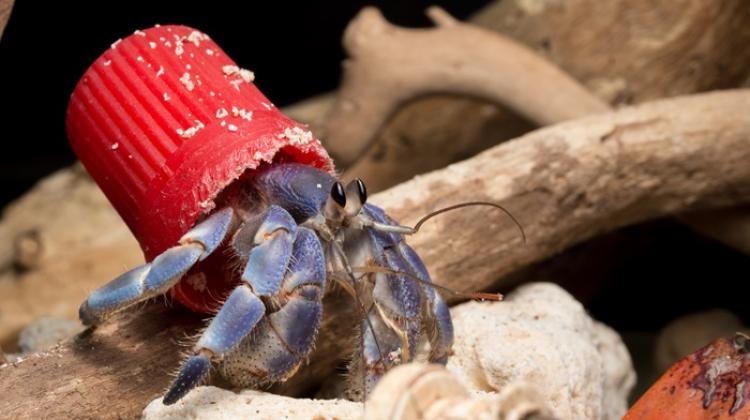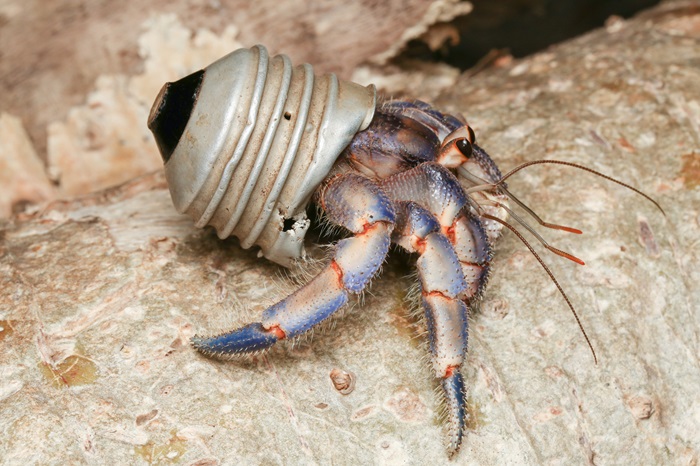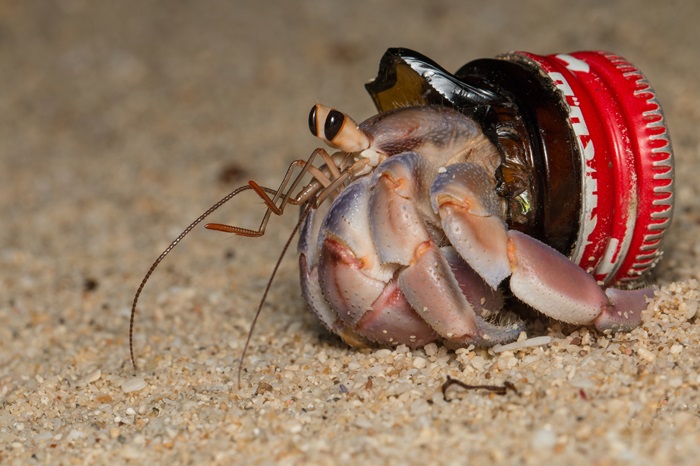Crabs and the Anthropocene: Bottle caps instead of shell houses
 A hermit crab in a plastic cap. Credit: Shawn Miller, photo from press release
A hermit crab in a plastic cap. Credit: Shawn Miller, photo from press release
Many species of hermit crabs have started using plastic covers instead of 'traditional' shells of animal origin. Scientists from Poznań and Warsaw describe this phenomenon in Science of the Total Environment. They emphasise that this is one of the signs of the environmental changes of the Anthropocene: plastic pollution on a massive scale.
Plastics are the most common waste found in seawater. Numerous studies and observations indicate that they have a very harmful effect on wildlife and the environment. It also turns out that they can significantly alter the natural behaviour of animals, say the authors of the new analyses, Professor Marta Szulkin and Dr. Zuzanna Jagiełło from the Institute of Evolutionary Biology at the Faculty of Biology of the University of Warsaw, and Dr. Łukasz Dylewski from the Poznań University of Life Sciences.
'Hermit crabs need to protect their soft abdomen. They usually do this by hiding in shells left behind by dead crustaceans. One such hiding place is not enough for a lifetime because of the crab's development, but also because of intra-species competition.
The study authors add that instead of shells, these creatures started using plastic objects lying on beaches and in the water.

The researchers confirmed the emergence of a new behaviour in hermit crabs using research methods associated with iEcology (internet ecology meaning the use of various online data sources as a tool in ecological research).
The scientists analysed photos of hermit crabs from the Coenobitidae family published on social media and other online platforms.
'In the photographs, we discovered a total of 386 individuals using +artificial shells+ - mainly plastic caps, but also made from broken necks of glass bottles or metal ends of light bulbs. According to our calculations, ten out of sixteen species of land hermit crabs in the world use this type of shelter. This unusual behaviour is observed in all tropical regions of the Earth,’ the scientists write.

The have published the conclusions from the analyses in Science of the Total Environment (https://doi.org/10.1016/j.scitotenv.2023.168959). They also present the presumed evolutionary directions of individual species of hermit crabs in the Anthropocene. The factors influencing the choice of 'artificial shells' by these animals include sexual selection, the weight of plastics, odour stimuli, and the possibility of camouflage in polluted environments.
The scientists plan further research. They want to determine reasons for this behaviour and its impact on the evolution of hermit crabs. 'These analyses will deepen our understanding of the consequences of plastic pollution in marine ecosystems, as well as the evolution of species in the context of new evolutionary pressures associated with the Anthropocene,’ the researchers write.
PAP - Science in Poland
zan/ bar/ kap/
tr. RL
Przed dodaniem komentarza prosimy o zapoznanie z Regulaminem forum serwisu Nauka w Polsce.














